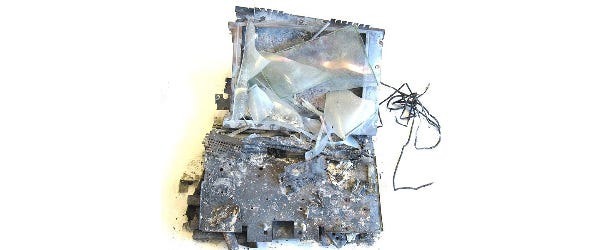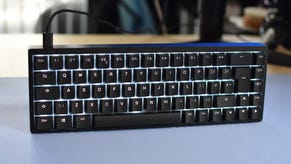Hard choices: Gaming laptops, Part One
What You Need To Know About Buying A Gaming Laptop
It's time to talk portable gaming. Not idiotic Angry-Birds-on-your-iPhone action, addictive as that may be, but proper performance laptops. Portable gaming PCs for real RPSers. Why? Some of you have asked for it. More importantly, it's got to be the trickiest PC-related purchase and one where there's little going back if you get it wrong. You're stuck with an ill-specified, largely non-upgradeable brick.
In fact, the whole thing is so very befuddling, we're going to split it into two parts. So, here's part one of everything you need to know about buying a gaming laptop.
Where it all began
As it happens, my personal portable-PC history makes for a handy potted guide to both the development of gaming laptops and some of the problem areas. Plus, you're a captive audience. I like showing off. Let's go.
I was in pretty near the beginning, right back at the turn of the millennium, earning my Counter-Strike stripes playing beta 0.6 on a 14-inch Dell Inspiron 4000. So that was a Pentium III mobile processor (130nm Tualatin, baby!) and ATI Rage 128 Mobility graphics with, if I recall, 8MB of graphics memory. Don't ask me the clocks. What I do remember is that it played CS fluidly at the 4000's 1,024 x 768 native. Bloody impressive for a thin-and-light of that vintage.
Then I graduated to a beastly 15-inch Dell Inspiron 8100 with the full-on 1,600 x 1,200 UXGA panel option. It shipped with a 32MB GeForce 2 Go GPU. It was actually a GeForce 2 MX-derived chip, sadly, not a GTS.
Following extensive research and a complicated overseas purchase involving a US-registered credit card and a shady mail-forwarding service, therefore, I procured an ATI Mobility Radeon 7500 card with a monumental 64MB of graphics memory. And I upgraded the Dell 8100.
That's right, upgradeable graphics
Yup, I upgraded the graphics. That's a major issue for laptops, so hold that thought for a moment. In fact, hold onto it until part two. Next up was a Dell Inspiron 8600. It was ground breaking in a couple of ways. Firstly it had a 16:10 widescreen panel with a massive 1,920 x 1,200 native res. Matching that resolution with a desktop monitor at the time would have cost more than the Inspiron itself.
The Dell 8600 also packed a GeForce 4 Go. That made it the very first example of a lappie with a downclocked version of the then most powerful available GPU. Put that GPU and screen together and you had what was arguably the highest fidelity gaming device on planet Earth. And it was a portable.
Since then, the gap twixt portable and desktop PC gaming prowess has waxed and waned. For a while it looked like downclocked version of flagship desktop GPUs would be the norm. The GeForce 6800, GeForce 7800 and ATI's Radeon X800 chips made their way into laptops without suffering any silicon to the surgery.
Then high end desktop graphics went a bit crazy, resulting in massive, power hungry GPUs that we're never going to cut it as mobile chips. The result is that most recent mobile graphics cards have been drawn from at best one rung down from the top tier of graphics chips. And so it is for my current steed, which sports a GeForce GTX 480M chip.
My dearly departed widescreen wonder
However, the release of NVIDIA's extraordinarily compact GK104 chip – the basis of the desktop GeForce GTX 680 – has rebooted high end mobile gaming. As it happens, its not necessarily my pick of the latest mobile GPU crew, but let's not get ahead of ourselves.
Back in that golden era of laptop graphics, you got what you paid for. If it said GeForce 7800, it was GeForce 7800. Even in a laptop. No longer. Both NVIDIA and AMD now use brand names and numbers as no more than rough indicators of position in the product hierarchy. It's more by chance than design if a product name really tells you what's lurking inside a notebook.
A typical example here is the NVIDIA GeForce 580M from the outgoing 'Fermi' generation of green-tinged mobile GPUs. It wasn't the same three billion transistor chip, codenamed GF110, as the desktop GTX 580. It was actually the GF114, aka the GeForce GTX 560. What's more, it's not much different from the GTX 480 in my old brick. The same sort of shenanigans apply to AMD graphics.
In truth, it's a bit of a nightmare keeping up. There's not space to list all the permutations here. But if you're serious about gaming laptops I suggest you put on the kettle, get comfy and hit up AMD's [http://www.amd.com/uk/products/notebook/graphics/Pages/notebook-graphics.aspx ] and NVIDIA's [http://www.nvidia.co.uk/object/geforce_family_uk.html ] reference pages. As ever, remember that things like core counts are not directly comparable between AMD and NVIDIA or even between generations from a single vendor. It's a pain, but that's the way it is.
Of course, there are a lot of relatively piss poor gaming GPUs among those lists. But it's not hard to boil them down to a smaller number of realistic options. I'm going to rule out anything with symmetrical multiple GPUs for starters. That means two of the same GPUs in SLI or Crossfire. If you've got money to burn, it might work out well for you. But if you've got money to burn, you can afford a few rolls of the dice and don't need my advice.
For everyone else, a single powerful GPU is the best bet, with the possible exception of a middling GPU hitched up to a fusion processor in a thin and light. But that's a relatively niche category. So what are my favourite mobile GPUs?
NVIDIA's excellent GTX 680 can now be had in lappies
The obvious candidate is the GeForce GTX 680M. It's the real GK104 deal, albeit chopped down from 1,536 CUDA cores to 1,344. Just as significant, the core clock falls from around 1GHz to nearer 700MHz. All told, you're looking at a chip with around two thirds the raw graphical grunt of NVIDIA's finest on the desktop. And that's pretty damn good.
I must confess I haven't had a chance to play with a 680M yet, but it's absolutely the obvious choice if you want maximum gaming performance. Because it's based on that extraordinary GK104 GPU, it's also available in vaguely sensibly-sized 15-inch laptops. So you can have the best performance without lugging around a 17-inch beast. Yay.
However, the really interesting chip in NVIDIA's armoury is the upcoming GK106. Built on 28nm silicon and smaller again and even more efficient than GK104, it looks absolutely pitch perfect for use in laptops with 960 CUDA cores. It's the mobile GPU I'd like to recommend above all others, so I've put the question into NVIDIA as to when we'll see it in notebooks. Watch this space for an update.
The problem, however, is that NVIDIA has already installed the old GF114 chip for use in the GTX 670M and GTX 675M mobile GPUs, so it's not obvious when GK106 can even fit into the product range. Anyway, in the meantime, those GTX 670M and 675M chips are very similar to the old GTX 580M and GTX 480M chips. They're all chips with split clockspeeds, roughly 300-odd cores from ye olde Fermi generation (rather than the brave new Kepler architecture in the 680 chips) and broadly similar performance.
In that context, if you see a great deal on a 480M notebook, don't turn your nose up. It could be worth a punt. Drop any further down the NVIDIA mobile range and performance falls off pretty rapidly. But the GTX 660M is a decent chip for something like a thin and light 14-inch notebook that dabbles in a little gaming.
Going thin and light is an increasingly interesting option
Anything below that and we're firmly into the territory of non-gaming laptops that may or may not cope with playing a given game, even at really low settings.
As for AMD, well, its mobile GPUs are generally a bit less visible on the market right now, but it does have some interesting chips. Its top 7900 series desktop GPU is an old school brute, so hasn't found its way into laptops, as yet.
Instead, it's the smaller 1,280-shader Pitcairn GPU from the desktop Radeon HD 7800 series that lends itself to the Radeon HD 7900M. Then there's the still the previous-gen 6900M series, which in turn is the same chip as a desktop 6800 series.
Now I know this all seems like a hideous mess. And it is. But all your really need to do is look at the core, texture and ROP counts, factor in the clockspeed, compare it to the closest desktop GPU and you'll get a good idea what to expect. It takes a little homework, but it's worth it.
As with NVIDIA's chips, go much further down the AMD range and you're giving up on what I'd call proper gaming ability, though again it's a little different if you're thinking thin and light. Or just really, really skint.
So let's recap on the GPUs:
1. My top pick from currently available mobile GPUs is obvious. It's the NVIDIA GTX 680M.
2. All of the following are interesting if the price is right.
NVIDIA GTX 675M
NVIDIA GTX 670M
NVIDIA GTX 580M
NVIDIA GTX 570M
NVIDIA GTX 480/485M
AMD Radeon HD 7900M Series
AMD Radeom HD 6900M Series
3. Don't go lower than that unless you are on a tight budget or you're going for a thin-and-light-come-Ultrabook lappie. The GTX 660M would be my pick for the latter. AMD's Radeon HD 7600M might be worth a look, too.
Phew! I should point out that big performance needn't cost the earth. You can have one of those top GPUs in a 15-inch 1,080p portable with a quad-core Intel processor for under a grand.
Tune in next time when we'll be discussing the virtues of whitebooks versus branded laptops, the graphics upgrade conundrum and the minor matter of screens. I may even have space for a little more discussion of gaming laptops on really low budgets. Toodles.













